Text
Final Project
The final project I am presenting for this class is a physical/visual art piece. The text of its language can be found below.
“have you passed through this night?”
the blood shows underneath,
like fibrous violets
my pale skin
spit out the bone
those fantastic masks
chalky bones
& black inks
veins of malachites
and deep reds
the wind in the dark
& the shame of a god
threads in
the center
Demons
and
Kobolds
god, the devil,
sheep, and
worms in us
burnt children
a sublime miscarriage
those
fantastic bones
and I found
the breath
in the one
organ
& little pearls
blood
and
rain
I have kept
only refuse
there
human, all too human
I am waiting for the bleeding.
--
Working Notes
For this project, I worked with language taken either from my previous poems or from Nietzsche’s Beyond Good and Evil. I was interested in explored embodied or physical forms for this work, both simply for the sake of that exploration and because the language itself is concerned with corporality (as I am starting to suspect a good deal of my work may be). In particular, I am interested in the idea of consuming, which can only happen with or within a body. Somehow, my poems have begun to feel like they are consuming something (me or something else?). Therefore, I wanted to give them a sort of physical presence - a body - as an answer to this consuming, desired or actual. Strangely enough, I seem to have projected by this effort a complex and animalistic existence on the visual/physical piece, which I can’t really describe.
0 notes
Text
Final Project / Poem
Link to final project: https://docs.google.com/document/d/1SxlPnpXSqLwqWm9TwJrBxTPoBmKrfu44ngI4Iym11Cw/edit?usp=sharing
This poem is intended to be a chapbook, so I’ll present a physical manifestation in class.
0 notes
Text
final project
“There is no alternative” - video link.
Working notes:
For my final project, I decided to make a video version of the anagram poem I made in week 5, which started off a sound poem, then became a powerpoint poem in week 8. When I made this poem into a powerpoint, I felt that that form was much more suited to the poem than either sound or a normally formatted poem on the page. Because of its reliance on anagrams, which are all about the manipulation of language as a material, it felt important to display the poem in a highly visual form, and to make it dynamic such that the way in which the language evolves is fully visible, in a way exposing the process of its creation. Though the powerpoint was a big improvement on these points, it wasn’t quite as smooth or dynamic as I wanted-- hence the video. I was excited about this medium because it’s new for me but still reflects my primary poetic interests, which are less in live performance or sound than in language as visual, and as self-generating/proliferating while still under some control by the poet.
I spent far too much time experimenting with adding more animation to text in Final Cut Pro (which was essentially brand new to me) and mostly failing, before I realized that most of the changes specifically to animation that I wanted could be made in powerpoint first before finishing it as a video in Final Cut. I used Final Cut to more smoothly adjust the color of the background over time, to better resemble the effect of a television being turned off or, say, the brightness of a screen being turned down, such that the final lines are almost fully censored from view (though most people should still be able to make them out, I think). I’m pretty happy with the result, which in style is simple just like the poem itself, but certainly reflects a new direction in which I can take my poetry. This format of poem somehow feels much more portable and easy to share with people than a poem on the page, perhaps because of the shareability of videos facilitated by social media.
In terms of feedback, one thing I’m interested to hear about is people’s thoughts on whether the video would benefit from the use of some kind of sound-- I experimented with adding some static-y background noise but decided against including it since it felt a bit too cheesy, though I’m still torn about this decision.
Secondarily, I also chose to revise my mad lib poem (here, if anyone’s interested) since I felt that this was one of the projects that had the most potential to expand. I added more specifics to some of the blank spaces as well as around them to guide the poem in a slightly more specific direction, while leaving enough vagueness for the improvisation to remain interesting. I also added more options for the instructions, such that the improvisation may be performed by either one or multiple people to different results. As a future project I would like to make more variations on these, and perhaps find someone who knows web design to help me convert it into an interactive online object along the lines of Jenny Holzer’s “Please Change Beliefs.”
-Anna Wood
0 notes
Text
Final Project
audio for c v dark:
https://drive.google.com/open?id=1y7hdxaV3gVQ_W8fOhFuYwF1TDFhW5Xxv
audio for str tl d wn :
https://drive.google.com/open?id=12qzHYVvgw_R_-Z04-TbQvVBkS9EanCup
str tl d wn score / companion piece:
https://drive.google.com/open?id=1tm9vZgfmrSVfgAJsCRk6zVoiYb0l-7k_
working notes:
https://drive.google.com/open?id=1J_sm2qmt37bc7mWkDeoBLipc0b0LgXiF
-nathan
1 note
·
View note
Text
Final poem
Attached here are instructions for my final project, also shown below. For class, I will be “the poet” for class today.
--
One person (the poet) assembles nine others, for a total of ten people (the players), arranged around a table.
The poet selects one ten-word sentence, which can be taken from any source (the poet’s imagination, another poem, a clothing catalog, etc.). The poet puts one word from the sentences on ten slips of paper, each. Along with the word, the poet puts two prompts on each slip of the paper. The prompts can be related to the word on the paper or not. The poet distributes the slips to the players in order (the person with the first word of the sentence sits next to the person with the second word, the second next to the person with the third, and so on). The players should not show their paper to the other players, or anyone else.
The player with the first word begins. A player may either respond to one of the prompts or say the word on their sheet. If the player responds to the prompt, they need not explain the prompt (for example, if the prompt is “Tell me the name of your mother” the player may simply say “Deborah” instead of “My mother’s name is Deborah”). If the player says their word, they may not respond to any more prompts. After the first player has made their utterance, the poem moves to the player with the second word. The second player has the same options as the first. Play moves around the circle. When the circle returns to the first player, if the first player has already said their word, they must simply repeat their word. If they have responded to a prompt, they may respond to the same prompt again or respond to the second prompt, so long as they don’t repeat what they have said (for example, if the prompt is “Tell me the name of your mother” and the player has said “Deborah” the player can not say “Deborah” again, but could say “Mrs. Baker”). They may also choose to say their word, after which they can only say their word. Play continues around the circle until the sentence is complete.
--
Working notes:
This idea began to foment in me after we did the Jackson Mac Low poem in the second week of class. In my fiction, I’ve been considering the idea of poetry that is experiential - that only fully exists in and is changed by the specificity of its participants and its moment. I wanted the poem, while still made up of its participants, to be guided by the writing. In its initial iteration, it was a poem that only would be performed once, for the final class, and be over. I was extremely stressed over this prospect and, for several weeks, I struggled to come up with the perfect ten-word sentence and the perfect questions to ask to make it a worthy bit of writing as well as a “fun exercise.” I realized this week, however, that this struggle was antithetical to the project which isn’t necessarily about me as a writer, but the way in which this poem changes with different participants. By making it both participatory and re-producible, it both takes the pressure off and allows for different iterations. I won’t say what I eventually settled on, to save the surprise for the class. - Ryn
1 note
·
View note
Text
Daniel Schwartz Final Project
I apologize in advance for how many links I’m including in my post this week.
This is possibly the last poetry class I will ever take, so I wanted my final project to feel like an appropriate end. The first part of my project is actually the first poem I wrote when I was in eighth grade. There are explanatory notes included in that document.
The first part of my project can be found here: https://docs.google.com/document/d/1KbA_UyV4TcoXOSvJfzu5Xk8tKryk5g3ssfzThOVbE2g/edit?usp=sharing
The second part of my project expands on my very first attempt at writing poetry. It takes the form of a video which can be found here: https://vimeo.com/272477405.
The text on the mime effigy and a picture of the mime before it was burned can be found here: https://docs.google.com/document/d/1xp-mINW-aNTlqjyhDjo4gI-Q5ak1vLOBloMwYdq3hGk/edit?usp=sharing
Working Notes:
I think most of this project is self-explanatory. As this quarter comes to end, I’ve been reflecting on what role poetry will play in my life in the future. From now on, it will take much more motivation on my end to make myself write since I will have no external pressure to make me write. In that way, graduating is a form of silencing because even if I continue to write poetry, it will be a very different experience that communicates in a different way, and I think that mimes are an appropriate symbol for this transition because they also experience silencing. I, just like mimes, will have to find a different way to communicate and express myself. However, I think there is something to be said for placing differing amounts of value on different forms of art and self-expression. For example, even though I could consider my work as a paralegal to be a kind of art, it does not have the same value for me as poetry.
I was also motivated by the idea of cycles. While on the one hand, I am circling back to my earliest poetry with this project, it is also very much a forward progression.
Daniel Schwartz, Final Project
0 notes
Text
LW: Final Project
http://philome.la/grey71237869
My final project is a four-part interactive hypertext poem. Together, they form a contemplation of trauma, abuse, embodiment, abjection and self-objectification, the difficulties of memory, and the problem of being a person who is also a circle, a broken robot, three text-to-speech programs, sixty ropes, glass, and/or a fish monster.
Part I, REFLEXIVE/RECIPROCAL, is a lightly revised version of my week 8 assignment, edited mainly to streamline the reading experience and text; I felt that it set up my interests and themes in other parts relatively well as-is, and also was satisfied with its somewhat self-contained arc.
Part II, DAUGHTERING, is a heavily edited and rearranged version of a poem conceived in its original linear version two years ago, included partly because of its direct subject-matter precedence of Part III, and partly because I wanted this assignment to involve the transposition of linearly-composed words into a heavily nonlinear form, as a way to extend my concept of hypertext practice after composing specifically for the medium in REFLEXIVE/RECIPROCAL. In this piece, unlike the other three, I explore branching and looping-- in this one not all paths return immediately to the previous branching point, and it is possible to proceed through the entire piece without seeing most of the text. There is also a dead end, which has to be escaped by using the “back” arrow, the only point in the poem at which I actively engage backtracking as part of the reading experience. At the same time, there are several points in the piece at which the reader can become stuck in a loop, obliging them to relive the same text several times over either consecutively or over the course of navigating the poem. This is meant to have certain obvious trauma analogies, as well as being an intentionally complicated concept to implement in an originally traditional/linear/lineated poem.
Part III, NOTHING TAKES ANYTHING, is a revision of my week 6 assignment of the same name. I include the audio from the original version, unedited, but I have rearranged the text so that it is meant to be experienced simultaneously with the audio through the active navigation of the reader. I have also “scored” the text so that it is rendered layered and illegible in ways almost entirely (though not perfectly) corresponding to the layered audio of the original track. This piece is entirely linear, with only one way of moving forward from each point to the next; this is partly because of the constraints of following an audio track and using visually complex text, but also seemed to suit the tone of inevitability/claustrophobia/restriction that I wanted to create in the piece.
Part IV, ABYS(S/M)AL, is a new piece, though again with roots in older work–– part of my interest here was the obsessive returning to the same themes over and over both in the piece itself and in my own body of writing overall, such that something I started years ago could slot easily in with work composed this month. I tried to keep this piece relatively linear while still using the units and framing possibilities provided by the medium. It also shifts into a more narrative and third-person tone than the previous three pieces. I wanted this piece to act as the companion to Part I in the same way that II and III go together, but IV is also in many ways the culminating result of the buildup of trauma over the course of the work, and meant to extend the work of all the pieces further.
#lw#poetry#final project#abjection#intimate partner abuse cw; parental abuse cw. just to be clear.#gender#leaving my violin unattended#territory-map nondistinctions#i've only had two thoughts over and over for the last five years
1 note
·
View note
Text
Week 9 Writing Assignment
https://drive.google.com/file/d/1C_HT7WqQauRaHBoMY1AMEDVN7IMunVQl/view?usp=sharing
For me, this week’s prompt raised a question: what counts as a public space? What do I consider the principle public spaces that I occupy, and would want to complicate, with a poem? I came to the conclusion, somewhat horrifyingly, that I think my body is a public space.
There are a lot of ways in which my body, as a public space, is an unmarked space of low conflict— I’m white, I’m thin, I’m not visibly disabled, I generally have the resources and background to present myself in ways that minimize the friction between me and my environment. The point where I become a difficulty in a public space is usually on the question of gender (and, relatedly, in fact inextricably, sexuality). As my own presentation has shifted it’s become increasingly clear to me how contextual gender markers are. One person will confidently call me “sir” on sight and switch, stammering, to “miss” once I speak. Someone who sees me at a distance first thinks I’m a man; someone who sees my hands first thinks I’m a woman. In a group of less ambiguously male-presenting people (well, let’s not be coy, cis men), I may get read as male, dressed the same as my peers & with the same haircut; I may get read as female, because I’m higher-voiced and shorter— everyone is seeing the same set of things from me; I’m not changing; yet somehow I become something else entirely from viewer to viewer. Sometimes I get “lesbian” (if it’s from strangers, quite possibly “dyke”), which is arguably its own gender category, something at best on a diagonal, a significantly noncentral example of “woman”; if I am able to tell that a stranger thinks this about me, it is usually because they are significantly hostile; again, this isn’t because I’ve changed anything about myself that I can identify.
Whether I want my body to be one or not, it is a public space: it’s a surface upon which other people routinely and inevitably project their own expectations of what a person occupying a gendered category is and looks like. For this poem I made those projections explicit: I wrote a poem on my skin about ways I’ve been addressed or interacted with that seemed to manifest that friction. Then I went back out to be a public space again.
0 notes
Text
compliment cards
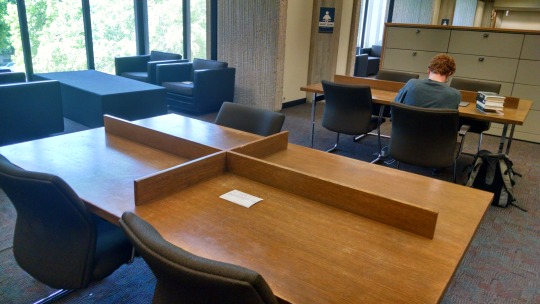
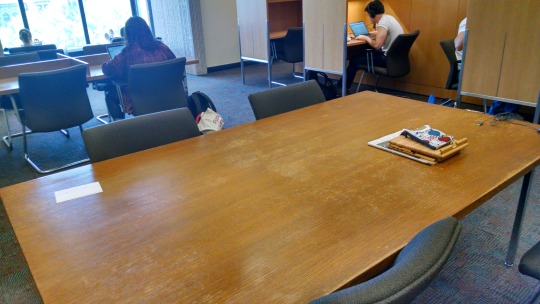
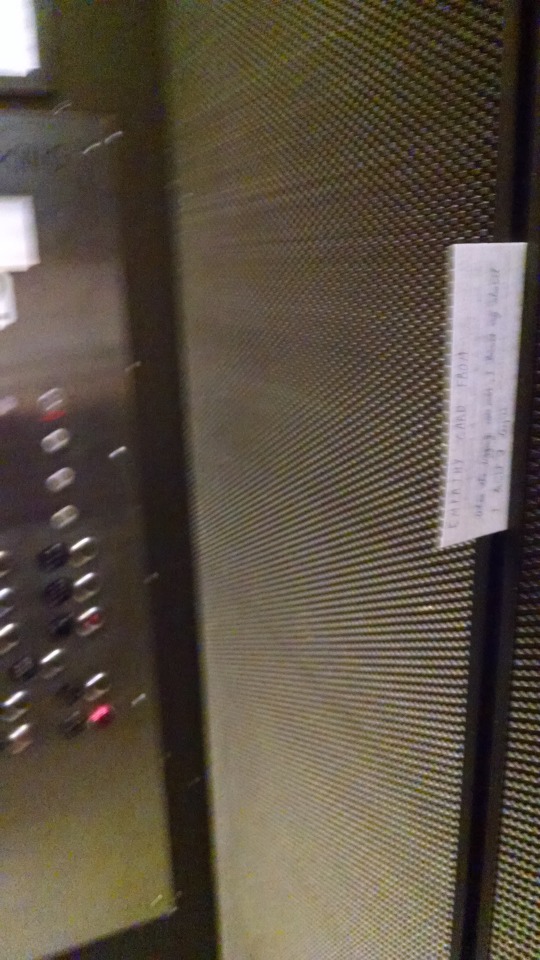
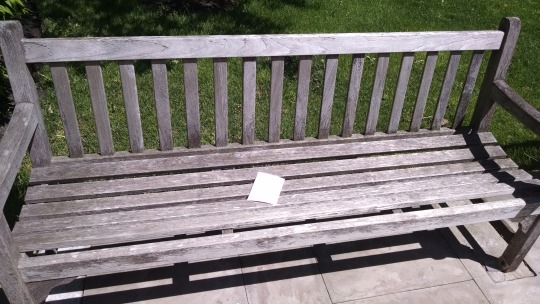
Pictures of all the notecards in themselves and of some in their new homes here
I have been captured by the idea of compliment cards – their quick, neat, cheeky, cheerleading nature which feels so fitting in our networked, quick-paced life. The cards participate in a new kind of care under capitalism wherein thoughtfulness can be premade and instant. But the cards also make fun of capitalism’s emotive lack, by extending attention, if not kindness, in almost the same manner we’re led to consume and accumulate commodities. My installation is a collection of compliment cards which I term “empathy cards” for reasons I shall discuss below.
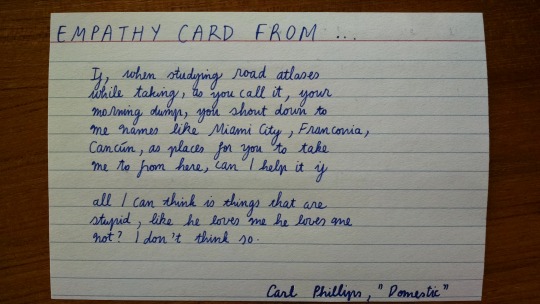
I crave the intimacy, slowness, and care we used to put in handwritten materials, especially correspondence. I decide to perform the same patience in the making of the cards, writing poetic lines and their accompanying explanations by hand. The latter I find quite repetitive, but I choose not to succumb to printing. Each card is filled on both sides: the front has some poem fragments I love from different poets, along with proper attribution; the back explains the intention and hope behind the card. Here’s my instruction to whoever finds these cards: “Please leave it here, take it with you, dock it somewhere new, give it to a friend or a stranger. Feel free to write on or around the poetic fragment”. I have the high hope that these cards will make enough of an impression on at least one person such that they will use it for personal purposes, or even alter the poetic lines to follow their mood. I put a header on the front: “EMPATHY CARD FROM …” so that they can fill in their name and give a card to someone else.
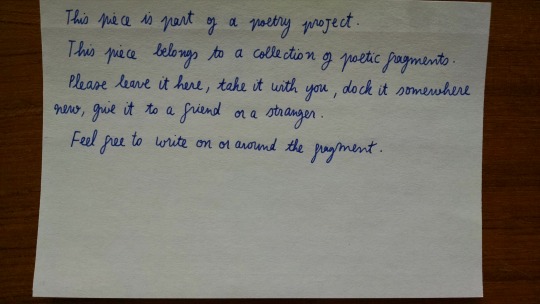
I’m able to make 15-20 cards, and the poetic fragments I choose are either lines from poems I have read and loved, or lines by poets I deeply admire. The process of negotiating what poems or what lines to use is challenging for me. Some poems belong to an uplifting, or at least personally relatable, vein in terms of their subject and mood. Some poems are just funny. But I tend to like poems of darker tones, which I think will not bode well with the quotidian, mass-friendly ambition of this project. So I end up not including some poems or poets I love. I very much enjoy, however, the challenge of negotiating intimacy with strangers, of imagining new potentials for poems I have been familiar with. It is an act of hope that the poetry can strike and reside with another human being. I was giddy to see a man in Reg hovering over a notecard I had left on a table.
I choose “empathy card” instead of “compliment card” because some of the fragments, if you look, can frankly not be considered “compliments”. I put the cards in many Reg tables. I also squashed one in the big elevator, which took me 10 minutes of riding the elevator up and down until I managed to find a nook to cram the card in with no one’s notice (the photo is really blurry because I perform badly under stealth and time pressure). I left some on the tables in Harper library but was too embarrassed to take pictures. I left some on benches in the Quad, for it’s a warmer day and people will be spotting the cards as they sit down I hope.
Should I extend this experiment further, I think I would like to create the poetic fragments myself. I was also considering putting my email address onto the notecards, so people could reach out if the cards compelled them. I decided not to, because the unknowingness is part of the vulnerable quality of this project. And I see myself as doing the job of poetry delivery – whether my effort is recognized doesn’t matter so much.
- Chi
0 notes
Text
Week 9 Reading Response
One work I enjoyed this week was Yepez’s Contexts and Signs of an Urban Visual Poetics. His sign-poems emphasize the social and material context of the poem as an integral part of the poem itself, which I see as an attempt to democratize poetry and make it more accessible to everyone. Yepez notes that there are many stylistic similarities between visual poetry and commonplace forms of discourse like advertisements and street signs, and consequently, visual poetry installed in public spaces can draw upon rhetorical techniques that are immediately familiar and understandable to people outside of the literary world. Moreover, once context poetry is installed in the street, it can no longer be said to “belong” to the author (nor, for that matter, may it belong to anyone at all, which is why Yepez thinks context poetry is resistant to commodification), which further de-privileges the status of the poet and turns the poem into something available for anyone to derive meaning from. To me, this idea of poetry fully synthesized with architecture and the landscape is exciting.
Another work I enjoyed was Buried Treasure Island. Here, the spatial context—the island itself—became a sort of frame within which the BARGE crew conducted a multi-faceted series of investigations. I thought the most interesting part of this piece was the way it exists in numerous forms—as a guidebook, a performance, an installation, and an audio tour—without any particular form being the primary one. Various forms of language are united through their focus on the real and imagined histories of treasure island, such that the space of the island seems to become source material (sometimes literally, like in the case of their soil sampling) which is then shaped into widely-varying texts.
-nathan
1 note
·
View note
Text
Week 9 Reading Response
This week I looked at the Finlay works and Mirra’s Instance the determination.
An obvious contrast is the particular types or aspects of space that the works interact with. Finlay’s work is concerned, not exclusively, but heavily, with the outdoors: pieces like Untitled (Wave) interact with the outdoor both in the actual physical context of the piece and the content (”wave”) and form of the text, which builds up on itself as the eye moves left to right and forms a wavelike swell. Even pieces interacting more directly with manmade objects and spaces––e.g., Sails/Waves, meant to be part of a wall, Homage to Jonathan Williams, about a ship–– focus on the physical and natural; color and shape are emphasized, and most of the pieces involve the natural environment in addition to the manmade. The text Finlay adds to the space heightens the viewer’s awareness of its physical and nontextual properties by highlighting or transforming these properties through the poem.
Instance the determination, meanwhile, deals with its space in a significantly different way, consciously engaging with the space it occupies as a specific human institution. As other students mentioned, I had encountered parts of Mirra’s work many times, but was not actually aware of the origins of the piece. I think my only-mildly-questioning acceptance of the presence of the work is a testament to how seamlessly the texts fit into the specific institutional context and ethos of the wider installation space. The installation in Kent, for instance, seems minimally comprehensible in the narrow context of its placement in a building used exclusively for chemistry and physical sciences; a wider view of the text as one of many such pieces of indexing on campus immediately places it instead in conversation with the heavily text-linked University as a whole. Unlike Finlay’s work, any single piece of Mirra’s installation brings little out of its immediate physical context; it interacts with the buildings on an almost symbolic level, as the diffuse embodiments of the abstract entity of “the University.”
LW
1 note
·
View note
Text
Reading Response Week 9
It’s hard here not to talk about Helen Mirra’s work so, even though most people have already, I will as well. In this class, with Mirra, I think we have the best example of how text-based, installation poetry can be received and embedded in our daily lives through context and repeated exposure. I went to UChicago for many years before I realized the strange bits of index peppered around the humanities and social science buildings were part of an art-installation. Even as I enjoyed them, found them touchingly poetic, their meaning and reason for being plastered in the stairwells of Wieboldt, Harper, etc. eluded me. It’s also interesting to me the way in which it has lasted – the press release says it should have been taken down in 2009, but the indexes are still on many walls well into 2018. Mirra said in an interview (in regard to her self-professed ‘careful amateur’ status, but I think it applies here as well) that “Not-knowing is most intimate,” which feels appropriate. In the total lack of context, these bits of index become private experiences between the repeat viewer and the stairwell.
I wanted to compare this to a text-installation which is (forgive me) not on the syllabus, but I’ve also frequented many times, Belief+Doubt by Barbara Kruger at the Hirshhorn in Washington, D.C. I’m from the DC-area and the Hirshhorn is one of my favorite museums, so I try to make a trip each time I go home. Despite the fact that I feel somewhat ambivalent about it, I’ve visited this installation probably at least four or five times since it’s installation in 2012 because, well, it is unavoidable if you visit the museum. You must walk through it to get to other exhibits or even the bathroom. It’s text is as provocative as it’s bright colors and requirement of viewing (it’s also somewhat ironic that it seems to critique consumerism positioned as it is right next to the gift shop with customized merchandise for the exhibit and other Kruger pieces). Yet the experience of this work, unlike Mirra’s, is anything but intimate. It isn’t a single experience, but a shared one that seems to collapse in around you, requiring your attention on each visit – pulling you from other exhibits even in the museum. - Ryn
0 notes
Text
Writing Assignment Week 9
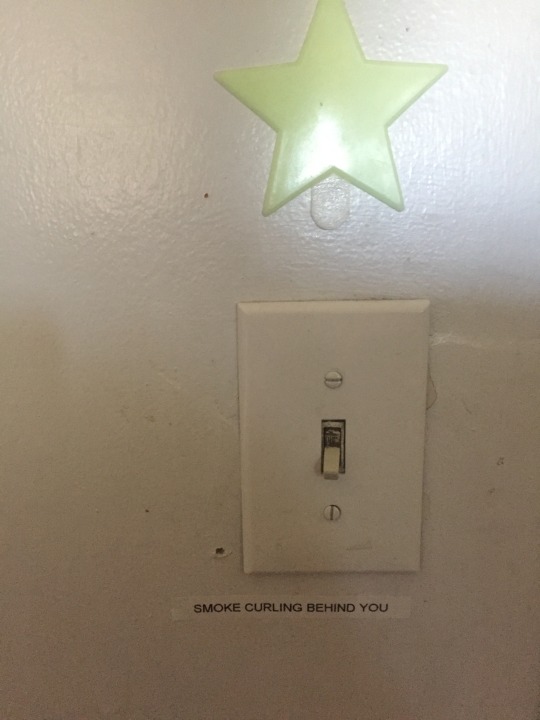
Above the coffee station
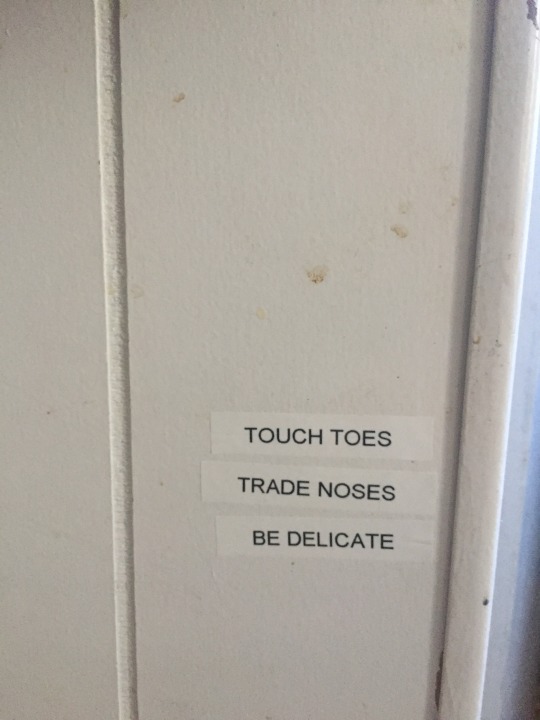
By the kitchen table
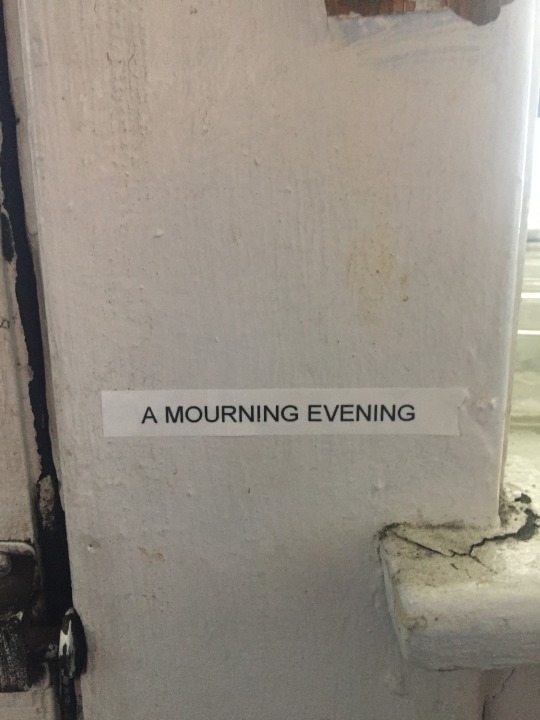
By the back door

Above the toaster
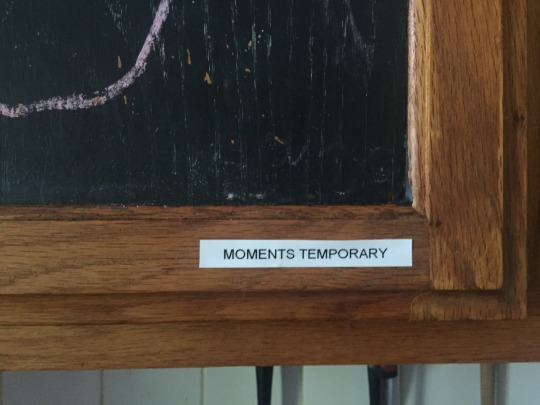
On a cabinet
This week, I struggled to think of a way to install language in a space that would both be meaningful, on a scale small enough to be feasible for a week’s worth of work, and documentable for the blog. I was inspired by my roommate, who, last summer, had a little bit too much fun with our label maker and labeled every jar full of something with the house. Now in spring, going into a new summer, none of the jars contain any of the things on their label – we regularly sip water out of “basil mint syrup” and make overnight oats in “trail mix.” They become funny little reminders of the person who made them, for my roommates and I to discover each day. I wanted to use our label maker to install poetry in our kitchen, for my roommates to discover. Because I couldn’t help myself, I told them I was writing them a poem, but I didn’t tell them what. This morning, I installed my words on the walls throughout our kitchen (I considered labelling objects or tables, but wanted something that wouldn’t be as damaged or disrupted by movement), for them to find. - Ryn
2 notes
·
View notes
Text
Week 9 Reading Response
This week, the works by Helen Mirra and the Surveillance Camera Players particularly interest me. Helen Mirra’s work is interesting to me mostly because I’ve been encountering it nearly every day for almost four years, and the Surveillance Camera Players’ work because I think it’s not nearly as great as they seem to think it is.
Helen Mirra’s work is relatively non-obtrusive and relatively permanent, as compared to the Surveillance Camera Players’ work is quite obtrusive, but only for a short while. Putting words on a wall takes up minimal three dimensional space, and does not force passersby to interact with it in the same way that the Surveillance Camera Players’ plays force people to walk around them and otherwise experience their presence. And while Mirra’s work has lingered on the walls of uChicago for years, the Surveillance Camera Players’ plays only really while they’re being performed, which isn’t very long, especially when the police come to end their performance.
This brings me to my next point about the physical spaces in which the pieces are located. Mirra’s work is in a university, and the content of it is specifically crafted to fit the space it inhabits. The Surveillance Camera Players install themselves in subway stops, and it seems like their main focus is on any given camera that represents the ubiquitous surveillance in public spaces. Mirra most likely had permission to install her work in a private setting, whereas the Surveillance Camera Players perform without permits or any other form of permission, which is theoretically permissibly because they are in public spaces.
Because the Surveillance Camera Players are such an obstruction and are so obviously trying to draw attention to themselves by holding dramatic signs and wearing weird costumes and performing in a crowded space, I feel like the bar should be higher for the messaging of their work, and to me, it falls completely flat. I think its impact can be summarized by the awkward conversation at 3:30 of 1984 when somebody asks the cameraperson why they’re doing this. The cameraperson responds by telling them that the piece is meant to show that there are surveillance cameras everywhere you turn. The passerby responds with “Yeah but, who doesn’t know that?” Their works doesn’t feel like it’s much better than somebody going out into a crowded street and yelling “Hey! Listen up! There’s air everywhere, and you can breathe it!”
Daniel Schwartz, Week 9, Reading Assignment
0 notes
Text
Week 9 Writing Assignment
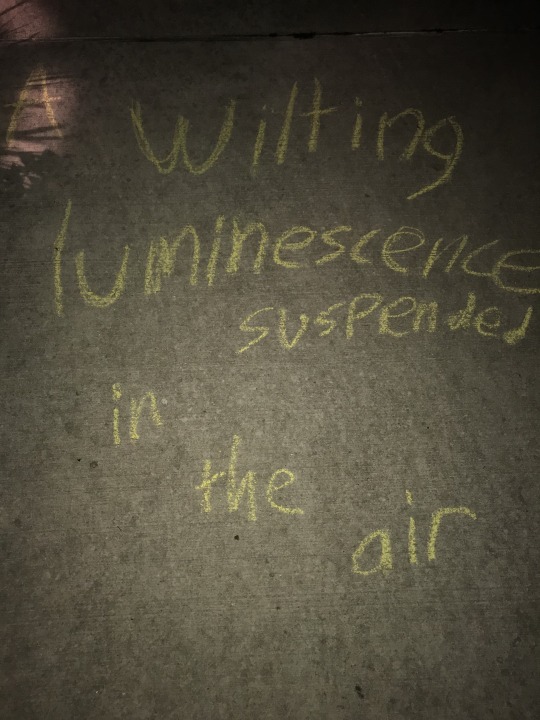
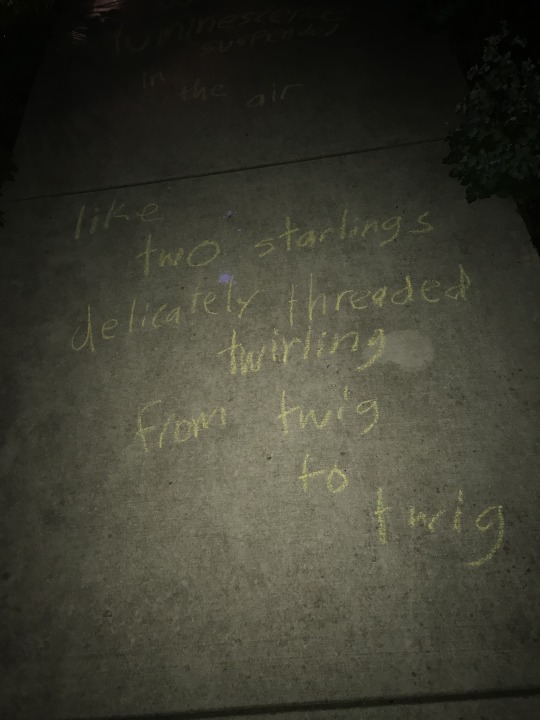
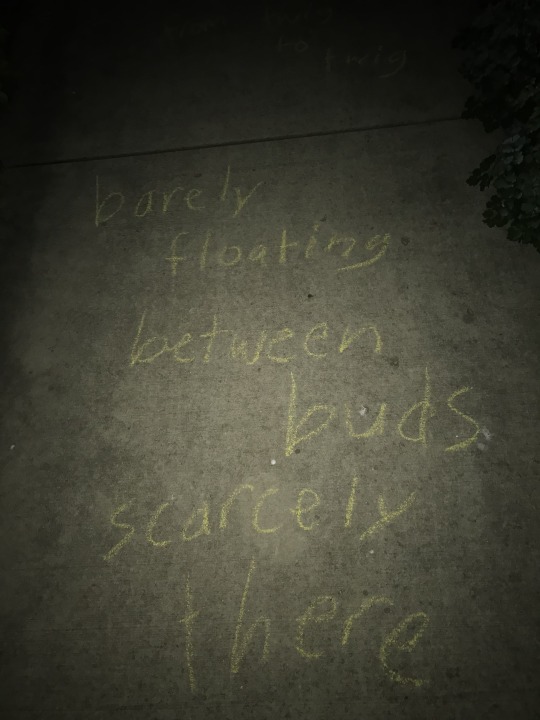
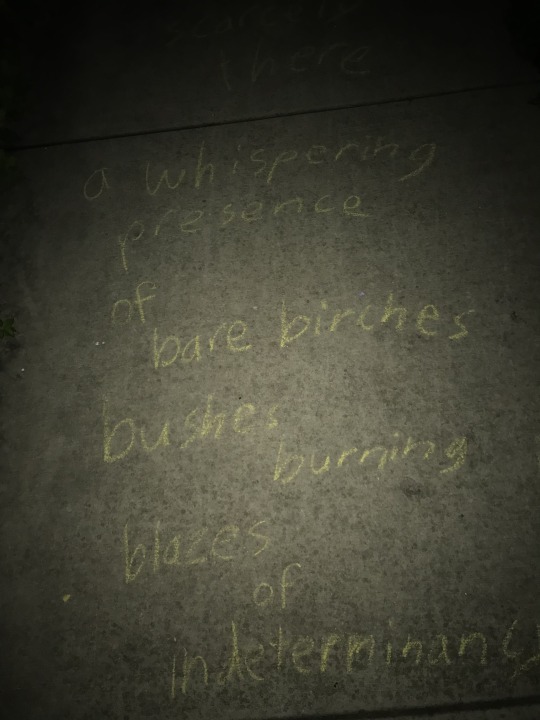
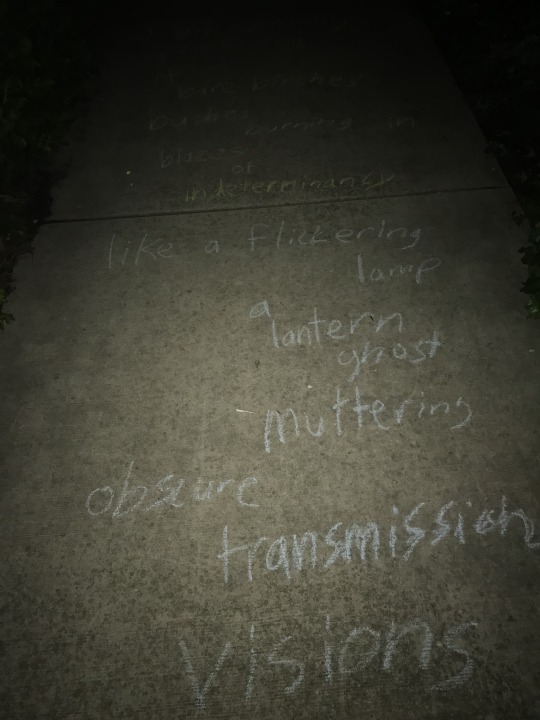
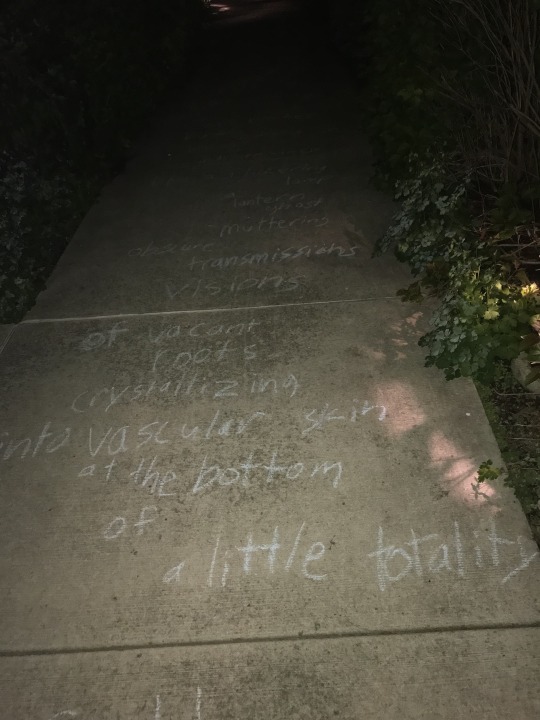



https://drive.google.com/open?id=15iKUVxJ0Pf2-EMWHNXBO3kOjMIpgqPN6
^link to transcript
My poem this week is written in chalk on the ground of some little path off of the Midway across from the law school library, and it offers some thoughts on transiency, presence, and absence. The poem itself was written to be read alongside the bushes and flowers surrounding it. The images and ideas contained within the words, I hoped, would somehow resonate with the material surroundings in a recognizable but open-ended way. I thought chalk was an appropriate medium to write in due to its extreme transiency. As soon as it rains, this poem will be gone, which to me is sort of interesting and appealing. I also liked chalk’s connotation as childish and playful. I saw the silliness of this medium as falling in line with Yepez’s argument for the de-privileging of poetry and his claim that poetry has no essence. Much of the work this week challenged the typical academic/institutional mystification of poetry into something that belongs in a privileged sphere of “high art” separate from everyday reality. I thought of the use of chalk as a move in this direction as well.
-nathan
1 note
·
View note
Text
Week 9 Writing Assignment
*** not presenting this week
Installation documentation/pictures (best to zoom in on pictures): https://docs.google.com/document/d/1sA810ncFbh-GDOUsB1evTMmbEB6pSQ5PgLu4bEaOqtM/edit?usp=sharing
Online component: https://docs.google.com/forms/d/e/1FAIpQLSdDN0VNhe8XzpTEecC-isImztq8tiXl3_I2NV7a2BjsLwssHQ/viewform?usp=sf_link (installation) and https://docs.google.com/spreadsheets/d/18ggUkTZ-UFPlYkpCbmOE_r9XaYTsdjmqLfzMc0Alyns/edit?usp=sharing (responses)
Working notes:
Inspired by Helen Mirra and feeling emotionally disconnected in an academically intense week, I wanted to create an installation that spoke to the distance that can arise between routine scholarship and unexpressed emotions. Inspired by Jenny Holzer, I wanted to embrace change and produce a piece that would change beyond my control. So I stayed simple: my installation is a prompt that I left around campus in areas with both foot-traffic and spots where people stop (an elevator, a water fountain, a bathroom stall, a bench). My hope is that people will add onto the installation, writing how they feel and responding with the context of the academic schedule, academic setting, and academic stress in mind. I plan to continually check on my installation, taking note of what’s been noted, and potentially transforming what changes into a poem of a different kind. I don’t expect the installation to stay for long (paper’s a flimsy material, scotch tape won’t hold for long, and I didn’t ask permission before posting) but my hope is to create some momentary interaction and reflection.
There’s also an online element to this installation. I created an anonymous submission form that collects responses (a la “Please Change Beliefs”) and posted the form to my Facebook and a Reddit community (r/SampleSize). So far, there are over 150 responses. Of course, there’s a huge bias (my social network and users on an online community), but that bias is part of the context of the piece. Going forward, I want to also incorporate those responses into a new piece, as well as compare online responses to physical responses.
- Ricky
#week 9#week 9 writing assignment#installation#art installation#poetry installation#how do you feel?#ricky novaes
0 notes
Text
Week 9 Wreading Response
After reading about and finally understanding Instance the determination by Helen Mirra, I tried to explain to a friend what those random words and numbers in the halls are. Despite the concise press release and my newfound knowledge of the installation form, I still found it difficult to explain how “Pauses, odd, 97” was poetic. Explanation seems to fall short because this piece seems to rely so much on context and feeling. The phrases alone are cryptically short, attached to seemingly random numbers, and ambiguously related. Yet this abstractness is fundamental to the art. Off of the page and onto the walls of hallways, the language of the installation becomes that of between class transience, noticed after hours of essay writing, glanced at in the middle of conversation. The installation becomes part of the university experience both as possible catalyst of thought and as an example of how there can be an art to academia.
***
Jenny Holzer’s "Please Change Beliefs" has succeed in changing my belief that a poem should be finished. The “Change” portion of her online installation is infinite — or at least as long as the adaweb holds on to the webpage and as long as future people find the site. While the list of truism itself stands as a poetic monolith, the endless mutations and free edits extend the list into a collective poetic mind. Initially I saw the ability to change whatever I pleased to be naive, even dangerous, in an open space of internet trolls and anonymous anyones, but the collected submissions are a testament to contribution, perspective, and freedom. Even the trite copypasta memes and repeated entries feel included, embraced between thoughtful edits that added (even without changing much). Change is experienced in every way outside of the page through the collectivity of many minds, much time, and an open platform.
- Ricky
0 notes